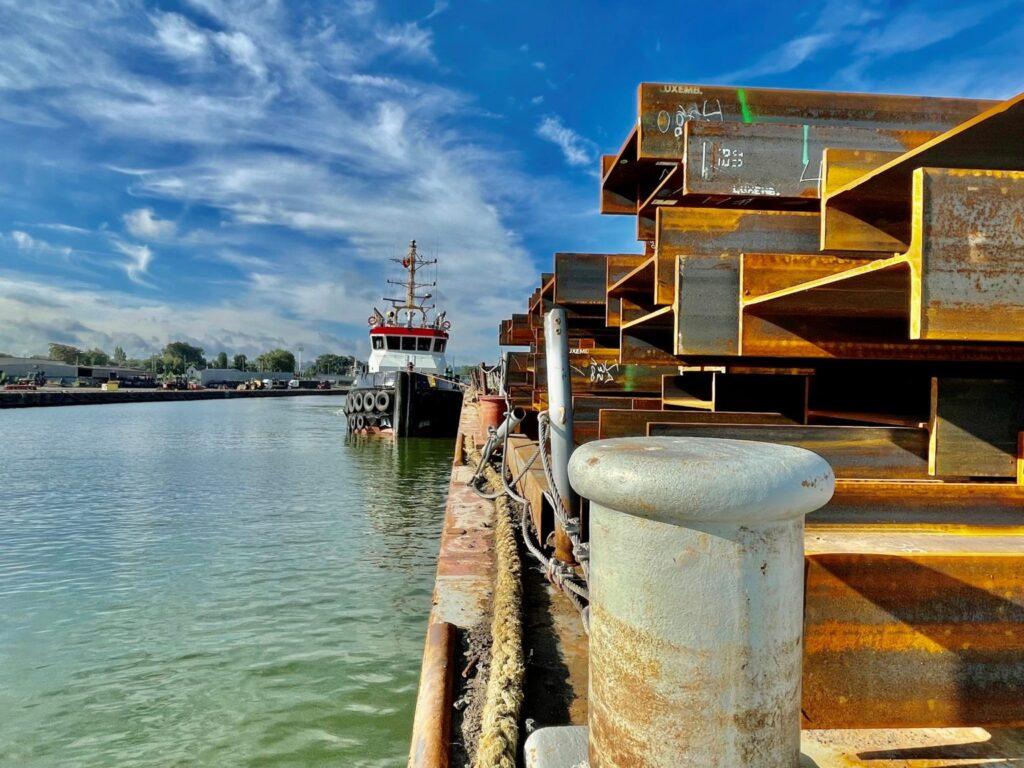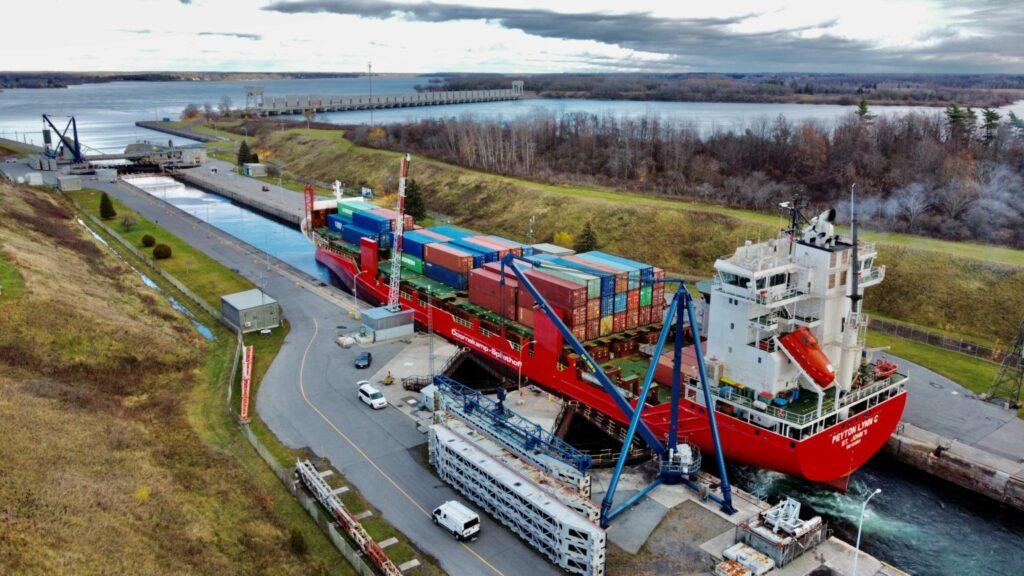
Photo Credit: Picton Terminals
H.R. Doornekamp Construction Ltd.’s transformative process of redeveloping, diversifying and modernizing Picton Terminals is not only valuable for the region, but also for the marine shipping industry as a whole.
An Ontario company is delivering on its wish to see the marine transportation industry better utilized. H.R. Doornekamp Construction Ltd., a family-owned business headquartered in Odessa, near Kingston, has reinvigorated Picton Terminals since it purchased the deep-water facility in 2014. And it has joined the ranks of marine transportation players with the launch of Doornekamp Lines to provide all-water services in Eastern Canada and into the Great Lakes.
“We have a lot of Dutch and European in our blood. So, moving items on water, the way the Europeans do, has always been of large interest to us,” said Ben Doornekamp, Owner of Doornekamp Construction. “When fuel prices did what they did (in 2008), it made it more evident that we had to become more efficient in moving product on water in the Great Lakes region.”
The first target on the Doornekamp radar was Picton Terminals, a facility built in 1953 for Bethlehem Steel to ship iron ore to the U.S. It closed in the 1970s following the closure of the nearby iron ore mine, then operated on a smaller scale under different leaseholders. Doornekamp saw the terminal as an opportunity to strengthen its construction services and support import and export services in the region.
“At that time we kept our eye on the port,” Doornekamp said. “The gentleman who owned it had mentioned to us that he was going to step away. He was a longtime construction guy in Kingston. My father was as well, so they knew each other well. They trusted each other. In 2014, the gentleman called us and asked if we were still interested. We said ‘yes.’ We met for breakfast and owned the port by the end of the meal.
“We had lots of huge visions and dreams for the port. We’ve been very fortunate. Not only have they come true, they’ve exceeded our goals. We’re extremely excited where we’re at right now.”
Among its efforts to redevelop, upgrade, diversify and modernize the terminal to be a pivotal hub in Eastern Ontario’s supply chain, Doornekamp has refurbished and fully computerized the shiploading conveyor systems, renovated buildings and retrofitted the port to store up to 2,300 containers. It also purchased a Liebherr LHM 420 Mobile Harbour Crane to handle bulk cargo.
Today, Picton Terminals moves a wide range of products, including construction material, steel and steel beams, aggregates, stone, gypsum, dredged sand, farming products, breakbulk and heavy-lift cargo, containers and bulk sugar. It even unloaded and stored last autumn two electric ferries that will sail in the Kingston region this year.
Kimco Steel Sales Ltd. has a working relationship with Picton Terminals to facilitate the movement of the Kingston-based company’s structural steel into the port.
“When it comes to providing great service to your customers in today’s instantaneous, fast-paced world, supply chain logistics is more important than ever. Picton Terminals’ personal touch and attention to detail really seems to shorten the chain, allowing Kimco the opportunity to receive our imports with efficiency and accuracy,” said Cody Rosen, Kimco’s Executive Director.

The Amy Lynn D tug transports a barge of steel from Hamilton to Picton Terminals. Photo supplied by Picton Terminals.
Doornekamp Lines
Doornekamp, which has a workforce of 80 to 100 people, has invested close to $30 million in its marine industry initiatives. It operates two Damen tugs, the Amy Lynn D, delivered in 2021, and the Sheri Lynn S, two flat-deck barges, as well as hopper barges from Picton Terminals under the Doornekamp Lines banner. In an effort to further capitalize on new opportunities, Doornekamp Lines is investing in container shipping.
The company started looking about three years ago at launching a scheduled domestic container and bulk cargo service from Halifax to Picton, with Picton being the connection to Toronto. “We did a ton of research, brought in a bunch of experts to help us,” Doornekamp said. The company announced plans in spring 2021 for the service and purchased a vessel, which it named the Peyton Lynn C. But before the service could even take off, Spliethoff, which operates the twice-monthly Cleveland Europe Express (CEE) between Europe and Cleveland, approached Doornekamp LInes about entering into a partnership.
“It’s pretty interesting how it came to be,” Doornekamp said. “In March of last year, we decided we were going to move on the domestic service, which was Step 1 – buying a container ship. About a week after we purchased it, Spliethoff approached us. We had always been trying to work with Spliethoff on their service. They asked if they could charter the vessel from us. That’s basically how it came about. A bit of a surprise plan.”

H.R. Doornekamp’s Peyton Lynn C. vessel in the St. Lawrence Seaway. Photo Credit: Picton Terminals.
The CEE is scheduled to start stopping in Picton, with connections to Toronto, this year. But Doornekamp is still looking “very seriously” at the Halifax-Picton service. “The vessel we had considered for that service has gone to Spliethoff on long-term charter and will stay there,” Doornekamp said. “We’re looking at what we’ve learned from the Spliethoff model, and we’re still looking very closely at another vessel for the domestic service that would sail Halifax into the Great Lakes.
“We would be looking at containers that move into Halifax that either move by rail or truck further into the U.S. or into the Great Lakes region. We’d be looking at moving that cargo by water – short-sea shipping.
“We are a small, private-sector player punching above our weight with the likes of large, established port authorities. Not many people start new ports today and, as such, there isn’t a prescribed process.
“We still have some challenges to get over. A lot of them have to do with government hurdles. It’s not as easy as you think getting over some of these hurdles. But we’re getting there. We are fortunate to be working with government staff who are helping us to stickhandle the many government agencies and policies to ensure regulatory compliance.”
Moving forward, increasing transportation efficiencies and providing an alternative to truck and rail transport and a more environmentally responsible option for domestic and international trade remain among Doornekamp’s main objectives and the cornerstone of its business plan.
“Stand by. We have some more projects coming down the pike in 2022,” Doornekamp promised. “It’s all related to Canadian shipping – improving it and expanding it for Canadian companies. Hopefully we can continue at the rate we’ve been going and make it a very positive experience for our customers.”